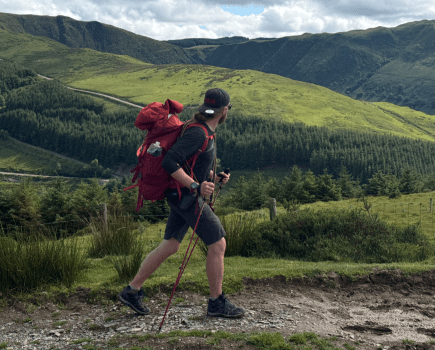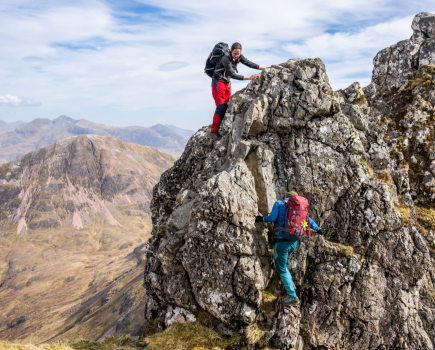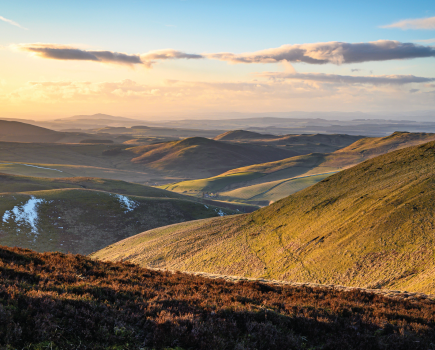
Dennis Kelsall takes an enlightening jaunt along the wildlife-rich Dorset coast
Jan’s brother and his wife make an annual pilgrimage to Dorset for the butterflies, orchids and other flowers on Durlston Head. We’d arranged to meet up for a nature ramble, but she fell ill at the last minute and we were left on our own. I know a little about a lot, but when it comes to identifying things out of the ordinary, I’m soon thumbing through my field guide and we were disappointed not to have an expert with us to point out the rarities.
We set off past the great Globe, an impressive sculpture depicting the world and surrounded by fascinating facts for the edification of Victorian visitors, who would no doubt, like me, be astonished to learn that the common black swift can fly at 200mph. In those days, the trippers could have gone on to explore the Tilly Whim Caves, abandoned quarries that are now home to colonies of bats and nesting seabirds.
Continuing below Anvil Point Lighthouse we kept an eye open for bottlenosed dolphins, which although often appearing in pods of ten or more, were conspicuously absent today. There was plenty of birdlife, however, with gulls and fulmars wheeling above the cliffs, occasional shags perched on the rocks and a hunting peregrine falcon, while the impressive scenery stretched from the Isle of Wight to St Aldhelm’s Head and distant Portland Bill.
Quarries punctuate the whole run of cliffs and Dancing Ledge is one of the biggest. The workings followed the rock strata deep into the cliffs, the cut stone being loaded directly onto waiting barges from the lower terrace, where tracks cut to guide the trucks are still visible. We passed more large quarries at Seacombe and Winspit, the latter famously used as a location for episodes of Dr Who and Blake’s 7.
Wandering on, we eventually reached St Aldhelm’s Head, where volunteers were giving the coastguard station a new coat of paint. Nearby is a squat, buttressed chapel, which possibly served as a navigation mark, while the headland was home to a WWII radar development station, the fact commemorated by an unusual sculpture in the form of a beacon basket.
The last stretch along the coast to Chapman’s Pool was both the most dramatic and the most energetic of the day, with an abrupt 200-foot descent and climb onto Emmetts Hill. Shortly after passing a memorial to the Royal Marines, we headed inland to find the pub at Worth Matravers. Overlooking a junction beyond the duckpond, it serves real ales, home-pressed cider, tasty pasties and pies,
and has a superb little
museum to boot.
Taking the high road back, we set off across the coastal downs where the steep hillsides still bear the terraces of medieval ploughing. Farther on, we paused to chat with a lady farmer who was laboriously pulling out ragwort. Although toxic to cattle and horses, it is the main food for cinnabar moth caterpillars and she was obliged to leave 10 per cent growing for them. We left her to it and carried on, later spotting a small group of roe deer grazing amongst the cattle. Eventually passing back into the nature reserve, we were bowled over by the profusion of flowers carpeting the slopes. Between them danced countless butterflies, including marbled whites, gatekeepers and chalkhill blues. The rare Lulworth skipper was about too. By now the pocket guide was out and we’d slowed to a snail’s pace, but the last mile made a grand finish to the day.
ROUTE DESCRIPTION
- Walk down beside Durlston Castle and the Globe to Durlston Head and follow Coast Path west past Tilly Whim. Stay below lighthouse at Anvil Point and continue to Dancing Ledge.
- Keep going past Seacombe and Winspit quarries, eventually rising onto St Aldhelm’s Head.
- Swing N with the coast, dropping steeply and then climbing onto Emmetts Hill.
- Reaching a junction of paths above Chapman’s Pool, turn inland, crossing a lane by a small car park to Weston Farm. Carry on into Worth Matravers.
- At the duckpond, go R and L to find a path off on L across fields.
- Dropping into Seacombe Bottom, walk L, shortly climbing steeply R to regain high ground. Continue E for 800m to kissing-gate.
- Cross the top of the next two fields, then bear R to gateway. Go L, mount stile and carry on, often close to L wall across heath and pasture for 2km.
- Re-entering nature reserve, bear left again to loosely parallel L wall. Eventually pick up service road from the lighthouse back to the car park.
Dennis Kelsall takes an enlightening jaunt along the wildlife-rich Dorset coast
Jan’s brother and his wife make an annual pilgrimage to Dorset for the butterflies, orchids and other flowers on Durlston Head. We’d arranged to meet up for a nature ramble, but she fell ill at the last minute and we were left on our own. I know a little about a lot, but when it comes to identifying things out of the ordinary, I’m soon thumbing through my field guide and we were disappointed not to have an expert with us to point out the rarities.
We set off past the great Globe, an impressive sculpture depicting the world and surrounded by fascinating facts for the edification of Victorian visitors, who would no doubt, like me, be astonished to learn that the common black swift can fly at 200mph. In those days, the trippers could have gone on to explore the Tilly Whim Caves, abandoned quarries that are now home to colonies of bats and nesting seabirds.
Continuing below Anvil Point Lighthouse we kept an eye open for bottlenosed dolphins, which although often appearing in pods of ten or more, were conspicuously absent today. There was plenty of birdlife, however, with gulls and fulmars wheeling above the cliffs, occasional shags perched on the rocks and a hunting peregrine falcon, while the impressive scenery stretched from the Isle of Wight to St Aldhelm’s Head and distant Portland Bill.
Quarries punctuate the whole run of cliffs and Dancing Ledge is one of the biggest. The workings followed the rock strata deep into the cliffs, the cut stone being loaded directly onto waiting barges from the lower terrace, where tracks cut to guide the trucks are still visible. We passed more large quarries at Seacombe and Winspit, the latter famously used as a location for episodes of Dr Who and Blake’s 7.
Wandering on, we eventually reached St Aldhelm’s Head, where volunteers were giving the coastguard station a new coat of paint. Nearby is a squat, buttressed chapel, which possibly served as a navigation mark, while the headland was home to a WWII radar development station, the fact commemorated by an unusual sculpture in the form of a beacon basket.
The last stretch along the coast to Chapman’s Pool was both the most dramatic and the most energetic of the day, with an abrupt 200-foot descent and climb onto Emmetts Hill. Shortly after passing a memorial to the Royal Marines, we headed inland to find the pub at Worth Matravers. Overlooking a junction beyond the duckpond, it serves real ales, home-pressed cider, tasty pasties and pies,
and has a superb little
museum to boot.
Taking the high road back, we set off across the coastal downs where the steep hillsides still bear the terraces of medieval ploughing. Farther on, we paused to chat with a lady farmer who was laboriously pulling out ragwort. Although toxic to cattle and horses, it is the main food for cinnabar moth caterpillars and she was obliged to leave 10 per cent growing for them. We left her to it and carried on, later spotting a small group of roe deer grazing amongst the cattle. Eventually passing back into the nature reserve, we were bowled over by the profusion of flowers carpeting the slopes. Between them danced countless butterflies, including marbled whites, gatekeepers and chalkhill blues. The rare Lulworth skipper was about too. By now the pocket guide was out and we’d slowed to a snail’s pace, but the last mile made a grand finish to the day.
ROUTE DESCRIPTION
- Walk down beside Durlston Castle and the Globe to Durlston Head and follow Coast Path west past Tilly Whim. Stay below lighthouse at Anvil Point and continue to Dancing Ledge.
- Keep going past Seacombe and Winspit quarries, eventually rising onto St Aldhelm’s Head.
- Swing N with the coast, dropping steeply and then climbing onto Emmetts Hill.
- Reaching a junction of paths above Chapman’s Pool, turn inland, crossing a lane by a small car park to Weston Farm. Carry on into Worth Matravers.
- At the duckpond, go R and L to find a path off on L across fields.
- Dropping into Seacombe Bottom, walk L, shortly climbing steeply R to regain high ground. Continue E for 800m to kissing-gate.
- Cross the top of the next two fields, then bear R to gateway. Go L, mount stile and carry on, often close to L wall across heath and pasture for 2km.
- Re-entering nature reserve, bear left again to loosely parallel L wall. Eventually pick up service road from the lighthouse back to the car park.








